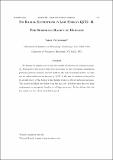No radial excitations in low energy QCD. II. The shrinking radius of hadrons
Author(s)
Friedmann, Tamar
Download10052_2013_2299_ReferencePDF.pdf (280.9Kb)
PUBLISHER_POLICY
Publisher Policy
Article is made available in accordance with the publisher's policy and may be subject to US copyright law. Please refer to the publisher's site for terms of use.
Terms of use
Metadata
Show full item recordAbstract
We discuss the implications of our prior results obtained in our companion paper (Eur. Phys. J. C (2013). doi:10.1140/epjc/s10052-013-2298-9). Inescapably, they lead to three laws governing the size of hadrons, including in particular protons and neutrons that make up the bulk of ordinary matter: (a) there are no radial excitations in low-energy QCD; (b) the size of a hadron is largest in its ground state; (c) the hadron’s size shrinks when its orbital excitation increases. The second and third laws follow from the first law. It follows that the path from confinement to asymptotic freedom is a Regge trajectory. It also follows that the top quark is a free, albeit short-lived, quark.
Date issued
2013-02Department
Massachusetts Institute of Technology. Department of PhysicsJournal
The European Physical Journal C
Publisher
Springer-Verlag
Citation
Friedmann, Tamar. “No Radial Excitations in Low Energy QCD. II. The Shrinking Radius of Hadrons.” The European Physical Journal C 73.2 (2013): n. pag.
Version: Author's final manuscript
ISSN
1434-6044
1434-6052